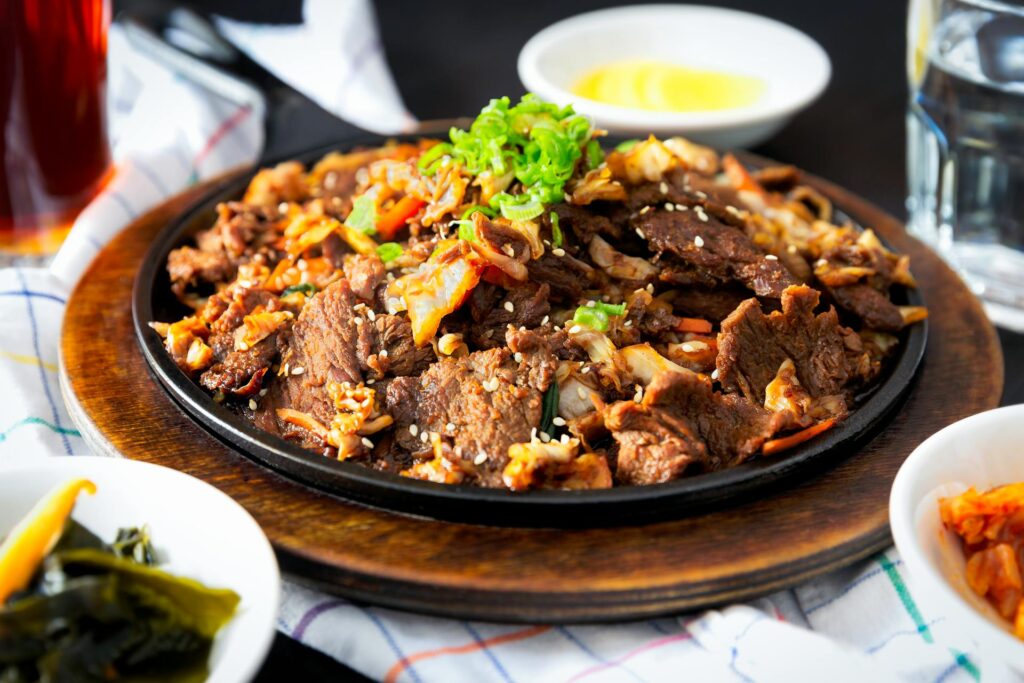When it comes to East Asian cuisine, Korean and Japanese foods stand out as two of the most popular and distinct culinary traditions worldwide. Both have unique flavors, techniques, and cultural significance that reflect their rich histories. In this blog post, we’ll explore the key differences and similarities between Korean and Japanese food, examining everything from ingredients and preparation methods to dining etiquette and health benefits.
1. Historical and Cultural Influences
| Aspect | Korean Cuisine | Japanese Cuisine |
|---|---|---|
| Origins | Influenced by Chinese cuisine, agriculture, and harsh winters | Influenced by Buddhism, Western culture, and island geography |
| Preservation | Heavy reliance on fermentation (e.g., kimchi) | Focus on fresh, seasonal ingredients, minimal preservation |
| Cultural Practices | Emphasis on communal dining | Emphasis on individual servings and aesthetic presentation |
Korean food has been shaped by centuries of agricultural traditions, harsh winters, and a strong emphasis on communal dining. Influences from China, due to historical interactions, are evident in dishes like jjajangmyeon (black bean noodles). The Korean Peninsula’s geography also encouraged fermentation as a preservation method, leading to staples like kimchi.
Japanese food, on the other hand, has been deeply influenced by Buddhism, which promoted vegetarian diets, and later Western influences during the Meiji Restoration. Japan’s island geography has made seafood central to its diet. The concept of “umami,” or savory taste, plays a crucial role in Japanese cooking.
2. Key Ingredients
| Ingredient Category | Korean Cuisine | Japanese Cuisine |
| Spices & Pastes | Gochujang (red chili paste), doenjang (soybean paste) | Miso, wasabi, karashi (Japanese mustard) |
| Vegetables | Kimchi (fermented cabbage), napa cabbage, radish | Daikon, shiso leaves, edamame |
| Proteins | Beef, pork, tofu | Fish, seafood, tofu |
| Condiments | Sesame oil, soy sauce, garlic, ginger | Soy sauce, rice vinegar, mirin, dashi |
3. Flavor Profiles
Korean cuisine is known for its bold, spicy, and robust flavors. The liberal use of garlic, chili, and fermented ingredients creates complex taste profiles. Dishes often balance sweet, sour, spicy, and umami elements, providing a dynamic eating experience.
Japanese cuisine emphasizes subtlety and simplicity, focusing on the natural flavors of fresh ingredients. Seasonings like soy sauce, dashi (broth), and mirin (sweet rice wine) enhance but do not overpower the dish, allowing each ingredient to shine.
4. Popular Dishes
| Dish Category | Korean Favorites | Japanese Classics |
| Rice-Based | Bibimbap, Kimbap | Sushi, Donburi |
| Noodle-Based | Japchae, Naengmyeon | Ramen, Udon, Soba |
| Meat Dishes | Bulgogi, Samgyeopsal | Yakitori, Tonkatsu |
| Street Food | Tteokbokki, Hotteok | Takoyaki, Okonomiyaki |
5. Cooking Techniques
| Technique | Korean Cuisine | Japanese Cuisine |
| Fermentation | Kimchi, doenjang, gochujang | Miso, tsukemono (pickled vegetables) |
| Grilling | Bulgogi, samgyeopsal | Yakitori, teppanyaki |
| Stewing/Boiling | Kimchi jjigae, sundubu jjigae | Nabe (hot pot), miso soup |
| Raw Preparation | Yukhoe (Korean steak tartare) | Sashimi, sushi |
6. Presentation and Dining Etiquette
| Aspect | Korean Dining | Japanese Dining |
| Serving Style | Family-style with banchan (side dishes) | Individual servings with artistic plating |
| Table Setting | Rice, soup, main dishes, and banchan arranged together | Organized placement, attention to aesthetics |
| Etiquette | Sharing dishes, using spoons and chopsticks | Using chopsticks correctly, silent appreciation |
Korean meals are often served family-style with multiple banchan (side dishes) accompanying the main course. Sharing is common, and the table feels abundant and vibrant.
Japanese meals emphasize presentation as an art form, focusing on balance, harmony, and seasonality. Meals are typically served individually, with specific etiquette rules like not sticking chopsticks upright in rice, as it’s reminiscent of funeral rituals.
7. Health Benefits
| Health Aspect | Korean Cuisine | Japanese Cuisine |
| Probiotics | Rich in probiotics from fermented foods | Moderate probiotics from miso and pickles |
| Omega-3 Fatty Acids | Moderate, depending on seafood consumption | High, due to seafood-rich diet |
| Sodium Content | High due to fermented sauces | Moderate, but can be high in soy sauce |
| Diet Balance | High vegetables, lean meats | Balanced with fish, rice, vegetables |
Korean cuisine emphasizes vegetables, fermented foods, and lean meats, making it rich in probiotics, fiber, and essential nutrients. However, high sodium levels from fermented products can be a concern if consumed excessively.
Japanese cuisine is often considered one of the healthiest diets globally, focusing on fish, vegetables, and minimal processed foods. The diet is low in saturated fats and high in omega-3 fatty acids, contributing to Japan’s high life expectancy.
8. Global Popularity and Influence
Both Korean and Japanese foods have gained immense popularity worldwide:
- Korean Cuisine: Driven by K-pop culture, Korean BBQ restaurants, and dishes like bibimbap and tteokbokki gaining global recognition.
- Japanese Cuisine: Sushi, ramen, and tempura have become international staples, with sushi bars and ramen shops in almost every major city.
9. Price and Accessibility
| Factor | Korean Food | Japanese Food |
| Affordability | Generally affordable, large portions | Varies; sushi can be expensive, ramen affordable |
| Ingredient Availability | Widely available (kimchi, gochujang) | Widely available (nori, miso, soy sauce) |
| Dining Experience | Casual BBQ joints to upscale restaurants | Casual ramen shops to high-end sushi bars |
Korean food often offers generous portions at affordable prices, especially for BBQ or hot pot experiences. Ingredients like kimchi and gochujang are widely available in international markets.
High-quality Japanese cuisine, especially sushi, can be expensive due to the cost of fresh seafood. However, casual dishes like ramen and donburi (rice bowls) are more budget-friendly.
10. Final Thoughts: Which One Wins?
Choosing between Korean and Japanese food comes down to personal preference:
- If you love bold, spicy, and hearty flavors, Korean food will satisfy your cravings.
- If you prefer subtle, fresh, and delicate tastes, Japanese cuisine will be your go-to.
Both culinary traditions offer incredible experiences that showcase the diversity and richness of East Asian culture. Whether you’re indulging in sizzling Korean BBQ or savoring delicate sushi, you’re in for a treat. Embrace the diversity, and don’t hesitate to explore both cuisines to discover your personal favorites.



